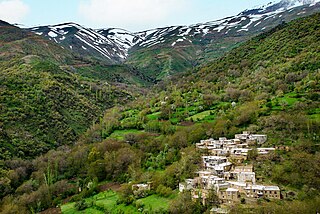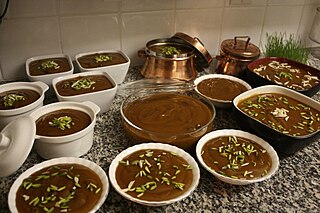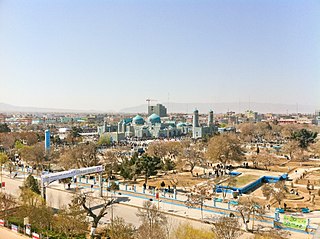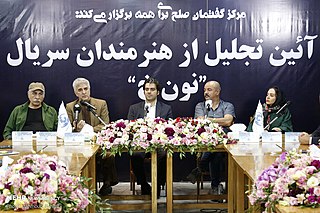The Iranian calendars or Iranian chronology are a succession of calendars created and used for over two millennia in Iran, also known as Persia. One of the longest chronological records in human history, the Iranian calendar has been modified many times for administrative, climatic, and religious purposes. The most influential person in laying the frameworks for the calendar and its precision was the 11th century Persian polymath, hakim Omar Khayyam. The modern Iranian calendar is currently the official civil calendar in Iran.

Nowruz is the Iranian or Persian New Year celebrated by various ethnic groups worldwide that started as a Zoroastrian celebration. It is a festival based on the Iranian Solar Hijri calendar, on the spring equinox—on or around 21 March on the Gregorian calendar.

Kurdistan or Kordestan province is one of the 31 provinces of Iran. The province is 28,817 km2 in area and its capital is the city of Sanandaj. Other counties with their major cities are Saqqez, Baneh, Marivan, Qorveh, Bijar, Kamyaran, Dehgolan, Diwandarreh and Sarvabad.

Mehregan or Jashn-e Mehr is a Zoroastrian and Iranian festival celebrated to honor the yazata Mithra, which is responsible for friendship, affection and love.

Khwaju Kermani was a famous Persian poet and Sufi mystic from Iran.

Motion pictures featuring Santa Claus constitute their own subgenre of the Christmas film genre. Early films of Santa revolve around similar simple plots of Santa's Christmas Eve visit to children. In 1897, in a short film called Santa Claus Filling Stockings, Santa Claus is simply filling stockings from his pack of toys. Another film called Santa Claus and the Children was made in 1898. A year later, a film directed by George Albert Smith titled Santa Claus was created. In this picture, Santa Claus enters the room from the fireplace and proceeds to trim the tree. He then fills the stockings that were previously hung on the mantle by the children. After walking backward and surveying his work, he suddenly darts at the fireplace and disappears up the chimney.
Naw-Rúz is the first day of the Baháʼí calendar year and one of eleven holy days for adherents of the Baháʼí Faith. It occurs on the vernal equinox, on or near March 21, which is also the traditional Persian New Year.

Hāji Firuz or Khwāje Piruz is a fictional character in Iranian folklore who appears in the streets by the beginning of Nowruz. His face is covered in soot, and he is clad in bright red clothes and a felt hat. He dances through the streets while singing and playing a tambourine.

Samanu, Samanak, Sümelek, Sumanak, Sumalak or Sümölök is a sweet paste made from germinated wheat and wheat flour, which is prepared especially for Nowruz in a large pot. This practice has been traced back to the pre-Islamic Sasanian Persian Empire. Although Samanu is prominent for "Haft-Sin", the preparation "mela" and eating it is traditional in Afghanistan.
Iranian folklore encompasses the folk traditions that have evolved in Greater Iran.
Snow 2: Brain Freeze is a television film starring Tom Cavanagh and Ashley Williams. It premiered on ABC Family in 2008 on their 25 Days of Christmas programming block. The made-for-television film is a sequel to the 2004 television film Snow.
Nane Sarma, also known as Bibi Barfi, is a mythical character in Iranian folklore. She is the wife of Amu Nowruz, the "Uncle Nowruz".

The Solar Hijri calendar is a solar calendar and one of the various Iranian calendars. It begins on the March equinox as determined by the astronomical calculation for the Iran Standard Time meridian and has years of 365 or 366 days. It is the modern principal calendar in Iran and is sometimes also called the Shamsi calendar and Khorshidi calendar. It is abbreviated as SH, HS or, by analogy with AH, AHSh.

Paytakht is an Iranian TV series directed by Siroos Moghaddam. portraying the life of a Mazandarani family in Aliabad village.

Nowruz is a cultural holiday in Afghanistan. It is also celebrated by many among the Afghan diaspora around the world. A day before Farmer's Day, the observance of Nowruz usually lasts two weeks, culminating on the first day of the Afghan New Year, March 21.

Santa Claus is a 1912 fantasy silent film in which a little girl dreams that she goes to Toyland where she helps Santa Claus in his workshop.
The Living Doll was a 1908 French short silent Christmas film by Georges Méliès. The film, combining American ideas about Santa Claus with Méliès's fantasy style and a modern touch, followed the adventures of a young girl, Polly, one Christmas night, as she escapes kidnappers, travels to Santa's palace, and—by changing places with a large doll—goes with Santa on a giftgiving journey by airplane.

Noon Khe is an Iranian comedy TV series portraying the life of a Kurdish family. It ran for 3 seasons and ninety-eight episodes over the course of 3 years (2018–2020) premiering during each Nowruz, the Iranian New Year, with the exception of second season that began in the Ramazan of 2020. The comedy series is written by Amir Vafaee, and directed by Saeed Aghakhani who is also the main character in the series.
Rastak Music Group is an Iranian contemporary folk music ensemble that was formed as an experimental music group in 1997. Rastak seeks to collect, record and interpret Persian folk music for a global audience.

Mullah Mohammad Jafar Sabzevari was one of the Iranian scholars and clerics of the 12th century AH, the Imam of Friday Prayer of the Shah Mosque in Isfahan and the author of several books and treatises including "Nowruznameh" and "Ma'ad" which was compiled at the request of Shah Sultan Hussein Safavid.












